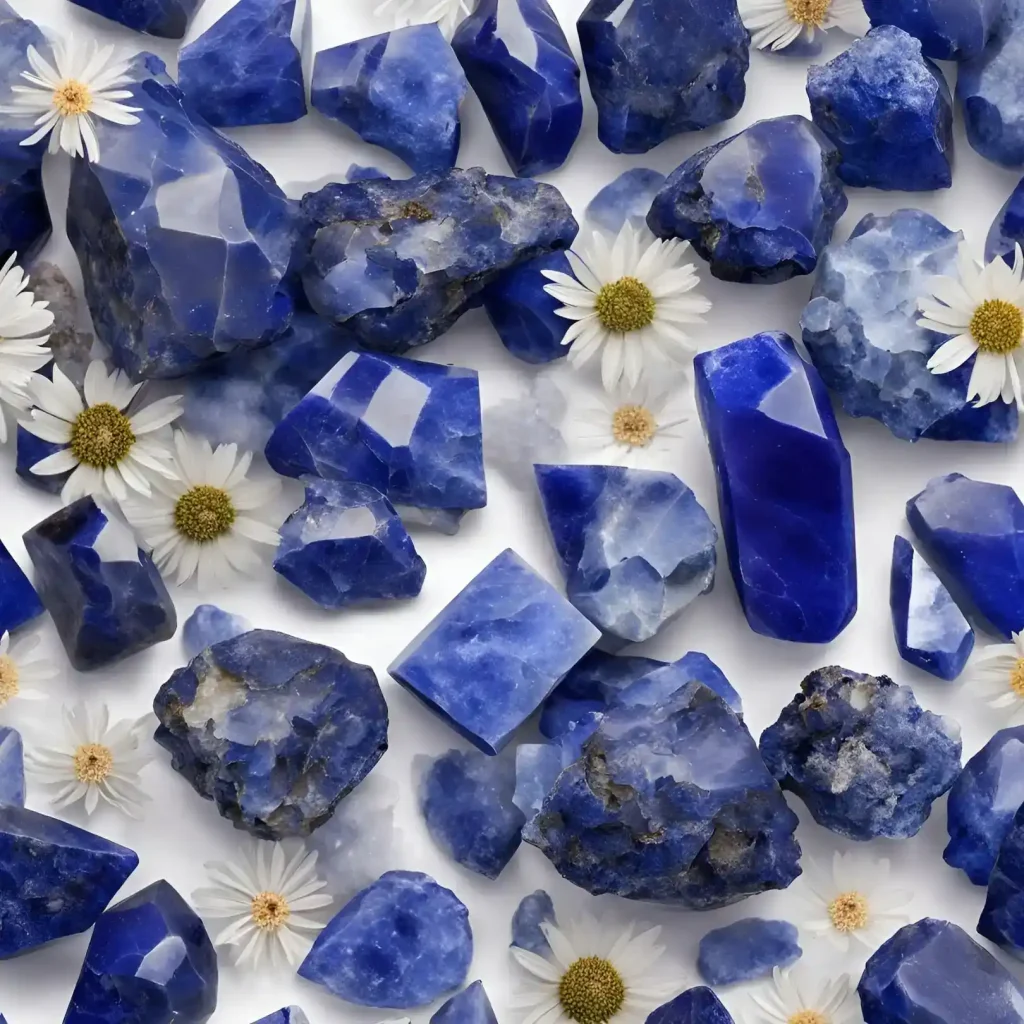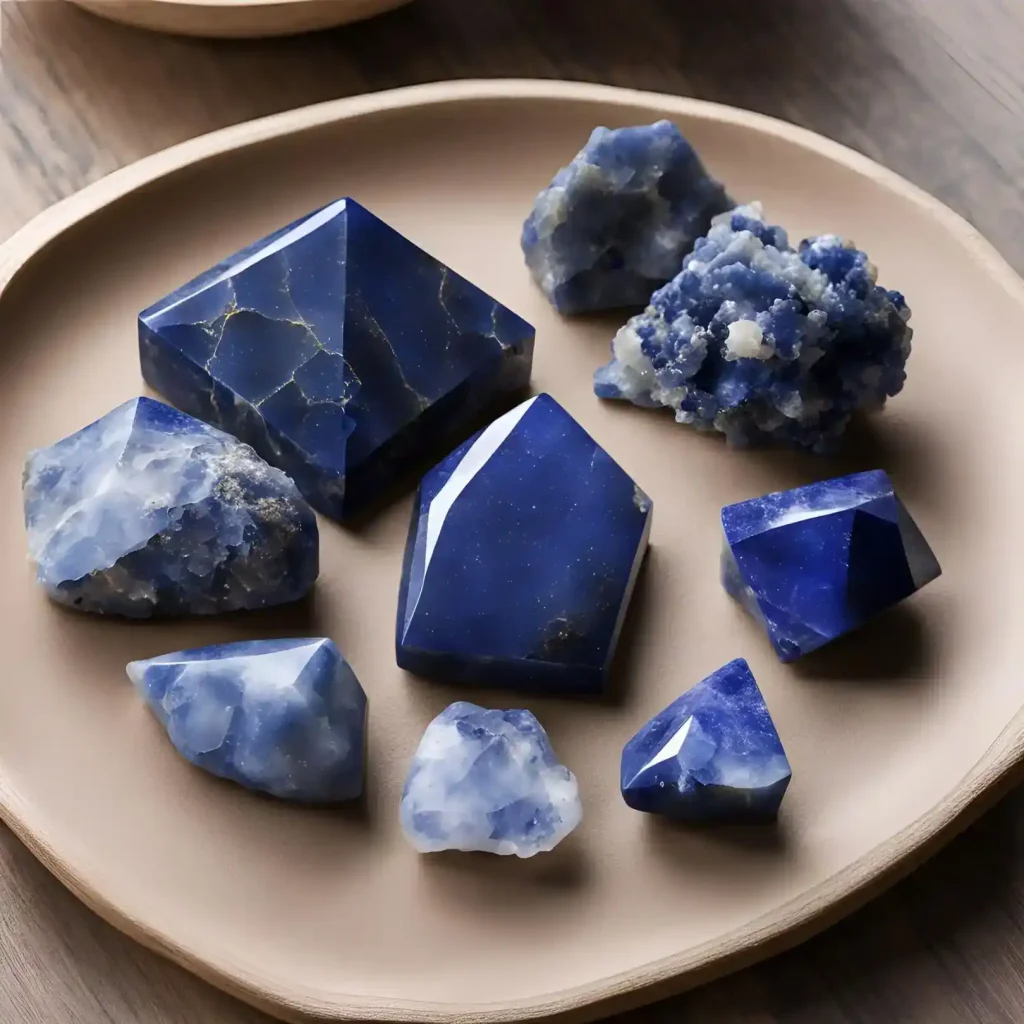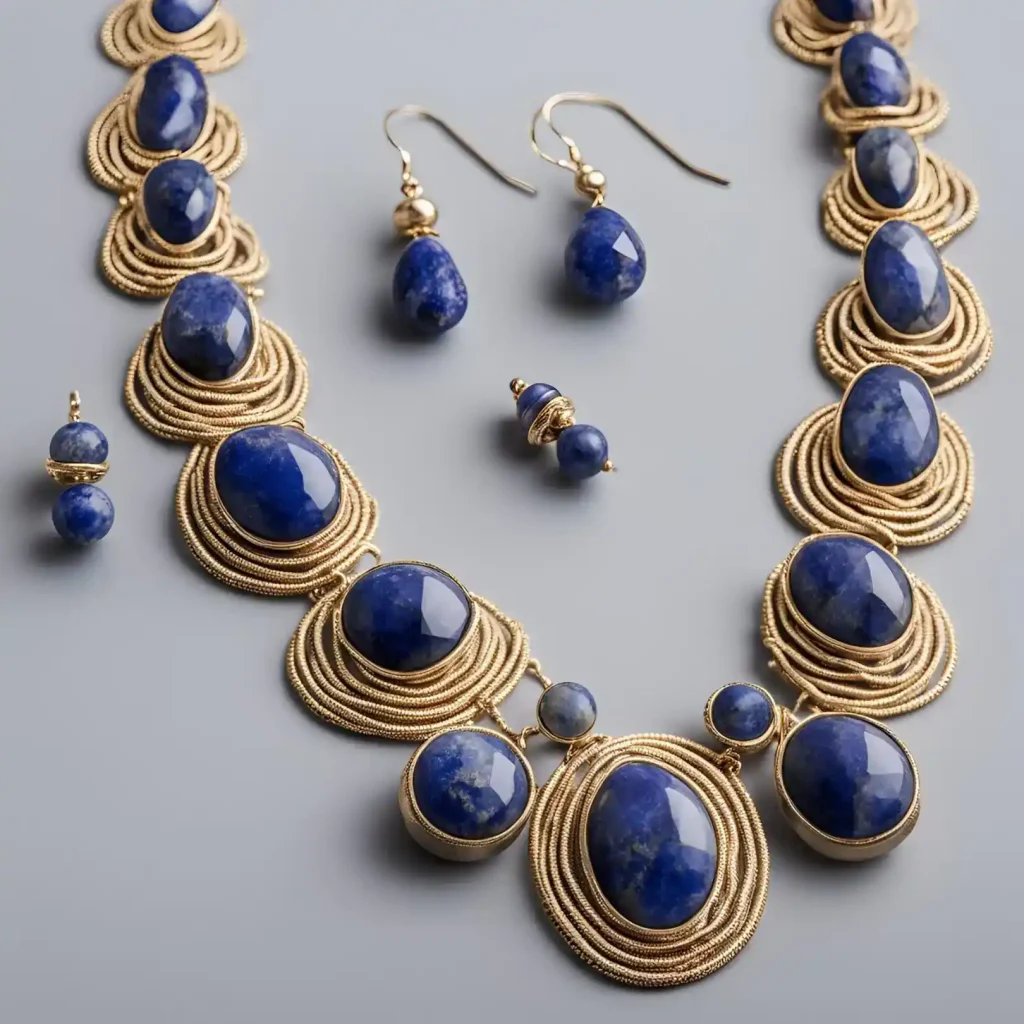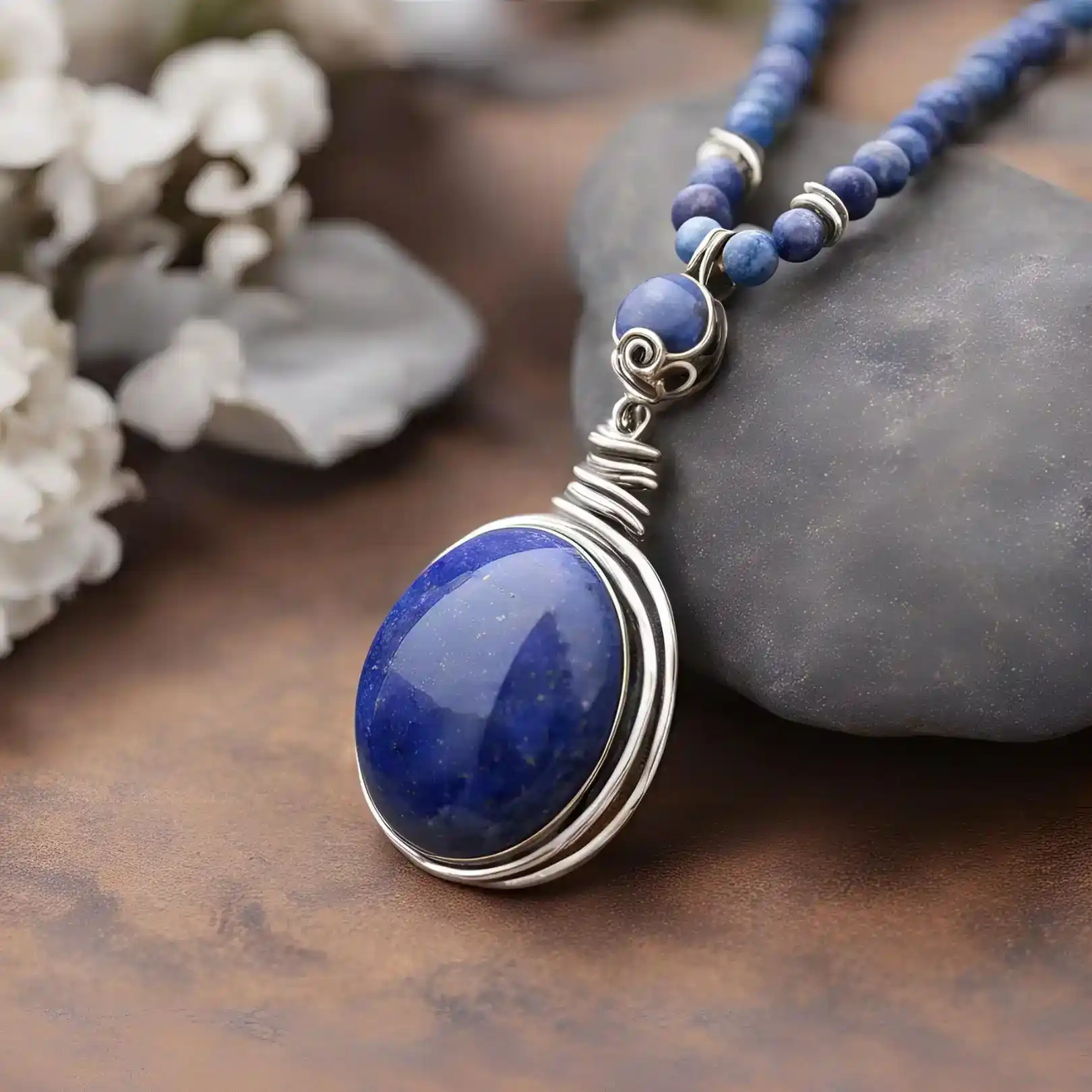Are you torn between choosing Lapis Lazuli or Sodalite for your next gemstone purchase?
Both stones offer beautiful shades of intense blue color, and their patterns can often be misleading, making it hard to distinguish between them.
Over the decades, gem enthusiasts and newcomers alike have scoured the internet, comparing photo after photo to spot the difference.
Both Lapis Lazuli and Sodalite serve not just as decorative stones but as educational tools. They act as a reminder and a teaching tool.
They help us understand the importance of chemical composition and hardness in identifying minerals.
Their appearance may look close in online images, but each has unique physical and metaphysical properties that assist those seeking a deeper connection with their spiritual path.
For instance, Sodalite tends to have a more uniform color and is often lighter than Lapis Lazuli, which contains pyrite that gives it a sparkly gold touch.
Also Read: How To Cleanse Sodalite Crystal
Introduction To Lapis Lazuli
Lapis Lazuli, often simply known as Lapis, is a stone with a royal blue color that has captivated civilizations like the Egyptian and Mesopotamian.
This stone has been prized throughout antiquity for its deep, intense blue hues that often contain specks of gold pyrite, which reflect the stars in the midnight sky.
The name “Lapis Lazuli” is derived from the Arabic term “Lazaward”, which means ‘heaven’ or ‘sky,’ pointing to its celestial shade.
This beautiful gem consists of a metamorphic aggregate of minerals like lazurite, the primary component, along with calcite and pyrite.
Occasionally, it contains afghanite, adding to its complexity. The presence of calcite gives Lapis pale streaks, while pyrite offers a sparkle, enhancing its appeal and value in jewelry.
Lapis stones are valued not only for their beauty but also as a metaphysical tool believed to provide protection and enlightenment.
The unique composition and quality of Lapis make it a sought-after material for decorations and jewelry.
It is identified by its color spectrum, ranging from violetish to medium-dark blue.
The uniform and intense coloration, along with the historical significance, contributes significantly to its trade value.
The process of how Lapis creates such vibrant color and appeal is a fascinating tale of geological creation and ancient admiration.
Also Read: Lapis Lazuli Negative Effects

Lapis Trade Grades
Lapis grades heavily depend on the color intensities and presence of calcite and pyrite.
The most obvious difference in grades comes from the matrix uniformity and the color tones: from medium to dark blue, often tinged with green or violetish shades.
Siberian Lapis, followed by Afghan and Russian, represents the top-valued grades, typically spotted for their rich, intense blue.
Chilean Lapis might contain a lighter blue and more calcite, then slightly lower in grade.
Lapis vs. Sodalite
Lapis and Sodalite are both beautiful, but they’re made up of different materials.
Lapis, or Lapis Lazuli, consists of lazurite, calcite, pyrite, and sometimes sodalite, with flecks of golden or white veining.
In contrast, Sodalite mainly comes from a calcium and sodium feldspathoid, often with similar blue colors but less calcium and potassium compared to Lapis.
Also Read: 8 Purple And Green Crystals For Positive Transformation
Lazurite vs. Lazulite
Lazurite and Lazulite might sound similar but are quite differentiated by their composition.
Lazurite, a key mineral in Lapis Lazuli, is a silicate, providing the deep blue color often found in Lapis.
On the other hand, Lazulite is a phosphate, typically intergrown with quartz, and does not contribute to the blue of Lapis.
True Lapis
True Lapis, primarily considered among the finest gems by ancient Egyptians, denotes a combination of minerals like lazurite, calcite, and pyrite.
This gem is known for its iconic blue color that gives it the appearance of the ancient skies, often used in jewelry representing truth and wisdom.
True Lapis is usually worn to reflect the heavenly bodies above, shaped into eye-shaped patterns, and occurs in intergrowth with diopside, enhancing its appeal and light-reflecting qualities.
Lapis Role In Art History
Lapis Lazuli has long been prized for its brilliant, vibrant blue color, making it a precious and valuable pigment in art history, especially during the Renaissance.
Artists utilized this gemstone by grounding it into powder and mixing it with oils or wax, creating the famed ultramarine paint.
This labor-intensive process reflected the pigment’s high cost and rare nature, which is why it was reserved for significant artifacts and paintings, often to depict Virgin Mary, symbolizing purity and divinity.
The deep, intense blue of Lapis not only enhanced the vibrancy and contrast in artworks but also added a symbolic weight to the features it adorned.
Its use was a choice that signaled the artist’s intent to elevate the subject’s importance.
In prehistoric times, Lapis was extensively used to decorate cave walls, dating back to ancient civilizations where its color was associated with the heavens, symbolizing a direct connection with the divine.
The bright, vivid hues were not only sought after for their beauty but also for their role in signaling cultural and spiritual significance.
The stone was so valuable, leftover bits were often recycled, a testament to its worth and the effort put into extracting every bit of vibrancy from it.
Also Read: 11 Stones That Look Like Turquoise

Spiritual And Metaphysical Beliefs About Lapis Lazuli
Lapis Lazuli is revered across various cultures as a stone that fosters self-awareness, inner peace, and spiritual enlightenment.
Its deep, vibrant blue color is associated with the night sky, symbolizing the universe’s vastness.
Traditionally used in meditation and worn as jewelry, Lapis is believed to aid in the pursuit of wisdom and truth.
Introduction Of Sodalite
Sodalite, a beautiful gemstone with a royal blue color often tinged with white, grey, pink, or green hues, is relatively softer and attractive.
Discovered in 1811 in Greenland, its name is derived from its sodium-rich chemical composition, Na8Al6Si6O24Cl2.
Sodalite is valued for its metaphysical properties, believed to promote emotional balance and tranquility, especially during panic attacks.
This mineral, typically found in igneous rocks and nepheline syenites, crystallizes at a Mohs hardness of 5.5 to 6, making it a popular choice for lapidary and jewelry.
Sodalite is also known for its fluorescence under ultraviolet light, showing bright yellow, orange, and green colors that enhance its appeal.
It is commonly used in arts and ornamental construction due to its perfect cleavage, vitreous luster, and vivid colors.
Sodalite’s historic and current use in sculpture and construction, combined with its limited availability in regions like Ontario, Canada, and its unique properties, contribute to its special status in the gemstone market.
Art and culture have been enriched by Sodalite since its discovery, and it continues to be a sought-after material for its beauty and functional properties.
Also Read: The Real Side Effects Of Wearing Copper Bracelet
Lapis Vs Sodalite Which Is Better
1. Pattern And Clarity
Lapis Lazuli is generally opaque, which means you cannot see through the stone.
Its surface is patterned with a striking blue color and often exhibits golden freckles due to pyrite, making each piece unique.
Genuine Lapis will show uniformity in this pattern throughout the stone, with white streaks or veining caused by calcite.
These streaks might appear more granular, adding to the authenticity and imperfect charm of Lapis Lazuli.
In contrast, Sodalite is more translucent than Lapis Lazuli and typically displays white veining on a light blue surface.
The calcite content can make these white streaks look different from those in Lapis; in Sodalite, they tend to be more uniform and less granular, contributing to a smoother surface pattern.
This stone also lacks the golden freckles seen in Lapis, which are a clear indicator of Lapis Lazuli.

2. Hardness Differences
When it comes to hardness, Lapis Lazuli and Sodalite show distinct properties.
Lapis Lazuli consists of a combination of several minerals, including lazurite, calcite, and pyrite.
This mixture results in a lack of uniform hardness, with the stone typically ranging from 3 to 6.5 on the Mohs hardness scale.
Sodalite, on the other hand, ranges from 5.5 to 6 on the Mohs scale, indicating a more consistent hardness throughout the stone.
Also Read: 14 Potential Side Effects Of Magnetic Bracelets
3. Location
Lapis Lazuli, initially found in Egypt and Mesopotamia, is a historically significant stone.
Today, it can be found in regions like Myanmar, Chile, and primarily Afghanistan.
In contrast, Sodalite was first found in Greenland and is now also located in Namibia, Canada, and South America.
4. Origin
Lapis Lazuli is a rock composed of several minerals, including lazurite, calcite, and pyrite, with sodalite as a minor component.
The primary component lazurite gives Lapis Lazuli its intense blue color.
It is primarily found in Afghanistan, specifically in the Sar-e-Sang district of the Badakhshan province, and has been mined for thousands of years.
Other significant sources include Russia, Chile, and Pakistan.
Sodalite is a tectosilicate mineral found in igneous rocks and metamorphic marbles.
It often forms in association with minerals like nepheline, calcite, and cancrinite. Sodalite’s name comes from its high sodium content.
It was first discovered in Greenland and is also found in various other locations worldwide, including Brazil, Canada, Russia, Namibia, and the United States.
5. Treatment
Neither Lapis Lazuli nor Sodalite is typically treated with enhancements. These relatively hard stones usually don’t require stabilization.
However, any fractures or cracks in either stone may be filled with resin or colorless oil to improve their appearance and durability.
It’s important to be aware of these treatments when purchasing gemstones, as they can affect the value and durability of the stone.
A reputable jeweler should be able to disclose any treatments done.
Here are additional things to keep in mind: avoid exposing Lapis Lazuli and Sodalite to harsh chemicals or cleaners. Remove them before swimming or showering, and store them in a cool, dry place.
Also Read: Discover Who Should Not Wear Jade
6. Affordability
High-quality Lapis Lazuli can be relatively expensive, especially those with intense blue coloration and minimal impurities.
Attractive golden pyrite flecks also add to its value. Prices for Lapis Lazuli vary widely based on size and quality, with larger, more vibrant pieces commanding higher prices.
Sodalite, on the other hand, is generally more affordable compared to Lapis Lazuli.
It is less rare and found in larger quantities, making it more accessible and budget-friendly for jewelry enthusiasts.

7. Astrological Benefits
Lapis Lazuli is believed to offer numerous astrological benefits. It helps in promoting self-awareness, inner peace, and wisdom.
Planetary associations with Jupiter and Venus make it beneficial for intellectual pursuits and emotional balance.
It is said to enhance communication, clarity, and truth, making it a perfect choice for speakers and writers.
Lapis Lazuli also aids in overcoming negative patterns, alleviating anxiety and depression.
This gemstone promotes self-discipline, spiritual growth, and inner harmony, which are essential for a balanced life.
Sodalite is associated with calmness, rational thinking, and emotional harmony.
It is thought to help in overcoming fear, enhancing self-expression, and promoting creativity.
Sodalite is associated with the planet Mercury, making it useful for intellectual and communication skills.
It is known to stimulate intellectual abilities, logical thinking, and memory retention.
This stone promotes a sense of trust and self-confidence, helping individuals to achieve their goals and improve their relationships.
It is also said to bring calmness, balance, and inner peace, making it an excellent choice for those seeking spiritual and emotional growth.
Also Read: The Dark Side Effects Of Blue Eye Bracelet
8. Popularity
Lapis Lazuli has been a popular choice for gemstones for thousands of years, particularly among ancient civilizations like Egypt and Mesopotamia.
Its distinctive blue color, often with golden inclusions, makes it sought after by collectors and artisans alike.
The intense blue of Lapis Lazuli is prized for its beauty and used in jewelry and ornamental items.
Lapis Lazuli remains recognizable and appreciated despite the higher cost compared to other gemstones.
People seeking a unique, historically significant stone often choose Lapis for its attractive appearance and decorative history.
Sodalite, while not as expensive as Lapis Lazuli, is still popular due to its affordability and attractive blue color.
Sodalite’s blue is less intense and often lacks the golden inclusions found in Lapis, making it a widely used alternative in jewelry and decorative objects.
Its history includes use in ancient Greece and Mesopotamia, and it remains a choice for those looking for affordable gemstones.
Sodalite is appreciated for its unique appearance and is often used by artisans to make beautiful items without the high price tag of Lapis Lazuli.
9. Price
Lapis Lazuli can be quite expensive, with prices varying greatly depending on quality, size, and color.
High-quality Lapis Lazuli with minimal calcite and excessive inclusions is more valuable.
The cost per carat can range from $1 to $100 or more. Larger stones with deep, vibrant blue color and fewer white veins are particularly prized.
Low-quality Lapis, with pale blue and many calcite inclusions, can cost as little as $1 per carat.
On average, prices for Lapis Lazuli can vary from $5 to $20 per carat, depending on the stone’s rarity and color intensity.
Sodalite is generally more affordable than Lapis Lazuli.
The cost of sodalite per carat typically ranges from $1 to $10, making it a budget-friendly option for jewelry enthusiasts.
High-quality sodalite with uniform blue color and minimal white veining can cost around $5 to $10 per carat.
However, low-quality sodalite with pale blue and excessive veins is less expensive, often costing less than $1 per carat.
The price can also vary depending on the size and quality of the stone, but overall, sodalite remains a more affordable choice compared to Lapis Lazuli.
Also Read: The Forbidden Beauty: Who Should Not Wear Peridot

10. Color Characteristics
Lapis Lazuli is renowned for its deep blue color, often highlighted by white calcite streaks and golden pyrite flecks.
These inclusions are not just imperfections; they are an important indicator of the stone’s natural composition.
The intense blue can vary from indigo to violet shades, making each piece unique.
The presence of pyrite gives it a saturated and sparkling appearance, which can differentiate Lapis from other blue gemstones in the field.
It’s important to note that the uniformity of the blue, especially when it appears very clear and bright, is a specific factor in identifying high-quality Lapis.
In contrast, Sodalite tends to have a rich, uniform blue color that can sometimes lean grayer than Lapis.
Unlike Lapis, Sodalite lacks the golden flecks of pyrite but may include white veins of calcite, which are less intense and more spread out.
Sodalite’s color is typically lighter, duller, and more muted compared to the vivid blue of Lapis Lazuli.
This stone often shows freckles or veining, which are slightly clearer and less saturated.
For gemologists and professionals in the gemstone field, these characteristics are key in accurate identification and comparison between the two stones.
Also Read: Unveiling The Powerful Spiritual Meaning of Earrings Falling Out
Final Thoughts
Lapis Lazuli vs Sodalite showcases two beautiful gemstones each with their own unique attributes.
Lapis Lazuli is known for its deep blue color, often with golden inclusions of pyrite, making it a desirable choice for jewelry and decorative objects.
Sodalite, on the other hand, offers a more affordable option with its uniform blue color and occasional white veins.
When considering lapis lazuli, it is essential to examine it closely, using tools like a loupe to see the calcite grains and pyrite flecks that set it apart.
Sodalite also needs closer examination to appreciate its simple beauty.
Regardless of your choice, both Lapis Lazuli and Sodalite bracelets are must-have additions to any gemstone collection.
Their special characteristics make them fabulous for jewelry and other decorative uses.
Regardless, whether you prefer the more established and expensive Lapis Lazuli or the more affordable Sodalite, both stones are arguably valuable and would make excellent additions to any collection.
Although these two stones may seem similar at first glance, closer examination firmly establishes their individual appeal.
